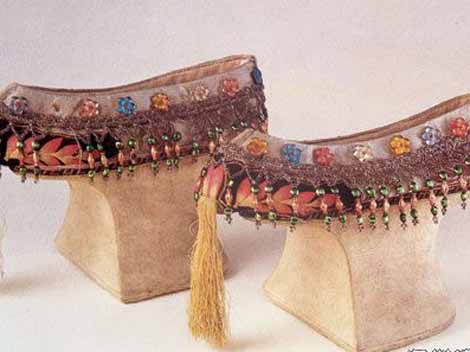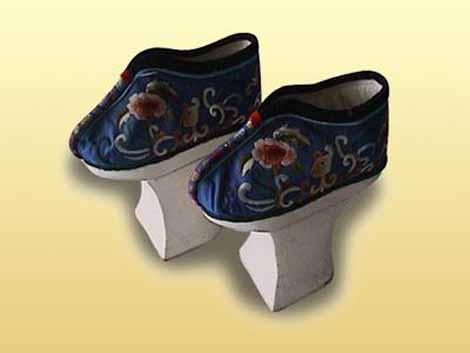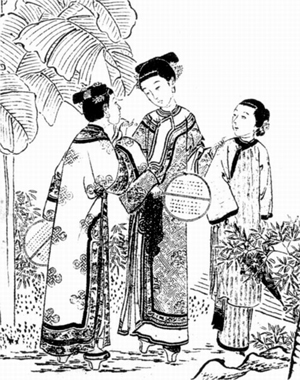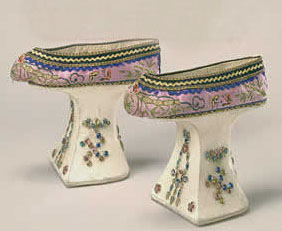
Manchu women have long had a reputation for being tall and slender. This may be because in former times they wore platform-soled shoes, tall hair styles and close-fitting cheongsams. There is a legend behind the height-enhancing shoes associated with Manchu women.

A queen named Duoluo Ganzhu is credited with inventing the forerunner to the distinctive chopine style of shoe. Her father was chief of a tribe that lived in Akedun city in the Mudanjiang River valley. At age 18, Duoluo Ganzhu was a beautiful, resourceful young woman who was of great help to her father in ruling over their people.
Another tribe lived on the opposite bank of the Mudanjiang River in Gudun city. Its chief was Hasiguhan, who was known to be evil, sly and lecherous. He desired Duoluo Ganzhu as his bride, and made several official proposals, all of which she refused. Infuriated at her rejection of him, Hasiguhan swore vengeance.

One autumn, Hasiguhan invited all the tribal chiefs to a hunt on Mudan Mountain. He cornered Duoluohan and killed him. After falsely accusing the hunt body guard of the murder he killed him too, and hung his head on the rampart. All citizens of Akedun deeply mourned the loss of chief Duoluohan. Hasiguhan sent a messenger to Duluoganzhu with the bad news telling her, "Tomorrow evening, I will accompany the hearse to the Mudanjiang River and wait for you." Duoluo Ganzhu told the messenger, "Please thank Hasiguhan for his kindness. I will go to meet the hearse tomorrow."
The next evening, heralded by a mournful bugle blast, Hasiguhan followed the hearse on horseback to the river bank and saw Duoluo Ganzhu on the opposite bank kneeling alone before the shrine. As soon as the hearse crossed the river he pulled a white feather from his helmet as a signal for the bugler to sound the attack. Soldiers concealed in the hearse leapt out and advanced with Hasiguhan, and he seized what he thought was Duoluo Ganzhu. But what he held in his grasp was actually a straw-stuffed manikin. Enraged, Hasiguhan commanded legions of
soldiers to attack Akedun city.
Duoluo Ganzhu and 2,000 soldiers and citizens of Akedun fled to the safety of an obscure village. After staying there for a month while Hasiguhan and his forces occupied Akedun, however, food supplies dwindled and many sickened and died. Duoluo Ganzhu needed to find a way of reclaiming Akedun city.
As she walked through a meadow one day, despairing at the sight of legions of enemy soldiers on the only road to Akedun, a flock of white cranes caught her eye. As she watched them a plan began formulating in her mind. She called her people together, telling them "The white cranes' long legs and webbed feet allow them to stand in mud without sinking. We could make our way on stilts to attack the enemy." Duoluo Ganzhu's plan appealed to the people, and they immediately began cutting down branches. Before long, everyone had a pair of crane-like wooden stilts. Duoluo Ganzhu and her troops, stilted and camouflaged in grass, walked through the mud to Akedun city and attacked. Hasiguhan was asleep. Neither he nor his troops dreamt that the enemy would be able to advance through the swampy meadow and storm the heavily guarded city. Lust for revenge gave Duoluo Ganzhu's forces the strength to defeat the enemy. Archers shot Hasiguhan to death as he tried to flee across the Mudanjiang River. Recapturing Akedun took Duoluo Ganzhu and her troops just a few hours.

As the other tribal chiefs despised Hasiguhan they welcomed Duoluo Ganzhu's victory over him. Before long all the tribes united and chose Duoluo Ganzhu as their Queen.
To commemorate this victory, Duoluo Ganzhu encouraged her women subjects to wear the elevated shoes that helped achieve it. As they were worn from generation to generation they gradually evolved into the distinctively stylish Manchu chopines.





